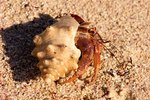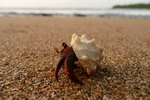
Hermit crabs are clean animals by nature, but they still need a little help from you. Unlike their wild counterparts, your crabs can't avoid their waste, so they rely on you to keep their sand tidy. Also, bacteria can build up on their climbing toys and food dishes, but spending a little time cleaning can keep your hermit crab healthy and happy.
Habitat
Often an aquarium, your crab's habitat—often called a crabitat—needs to be cleaned periodically, usually every few weeks. Your crab can survive in a safe container for a little while, so gently transfer him along with a small amount of sand. Take out all the toys and dishes and pour out the sand and gravel. Hermit crabs are sensitive to the chlorine found in most tap water, so use filtered water or water treated with a dechlorinator to wipe down the inside of the habitat. Don't use any chemicals, which can harm the crabs. Instead, a clean rag dampened with hot water should do the trick. Once the habitat is dry, add sand and toys, then your crab.
Sand
Although the sand needs to be replaced occasionally—about twice a year, in many cases—it needs cleaning a couple times a week. If your hermit crab is a neat one who doesn't turn over his water dishes, all you have to do is slide a plastic sand scooper through the sand. The scooper sorts debris, such as waste, discarded food and pieces of exoskeleton, out of the sand so you can dump it in the trash. If your crab likes to dump out his water, you might need to scoop out the wet sand and let it dry before returning it to the crabitat. Wet sand can grow mold, exposing your crab to dangerous organisms.
Toys and Dishes
Hermit crabs enjoy climbing, burrowing and hiding, so toys such as fake driftwood or small clay pots help make a crabitat a home. Wipe the toys down every couple of weeks with warm, dechlorinated water. Do the same with the food and water bowls, but wipe them every day—make sure the food bowl is completely dry before putting it back in the habitat. When you pull everything out of the aquarium to wipe it down, boil the dishes and toys in for a few minutes to completely kill any bacteria that's accumulating. Let them cool and dry before replacing them in the habitat.
Shells
Your crab usually changes shells when he molts, but he might opt for a change in between molts on a whim. It's a good idea to keep a couple of shell choices in the habitat just in case. Before you put them in, boil the shells for a few minutes, rinse them in dechlorinated water and let them air-dry.
References
Photo Credits
-
Brand X Pictures/Brand X Pictures/Getty Images




